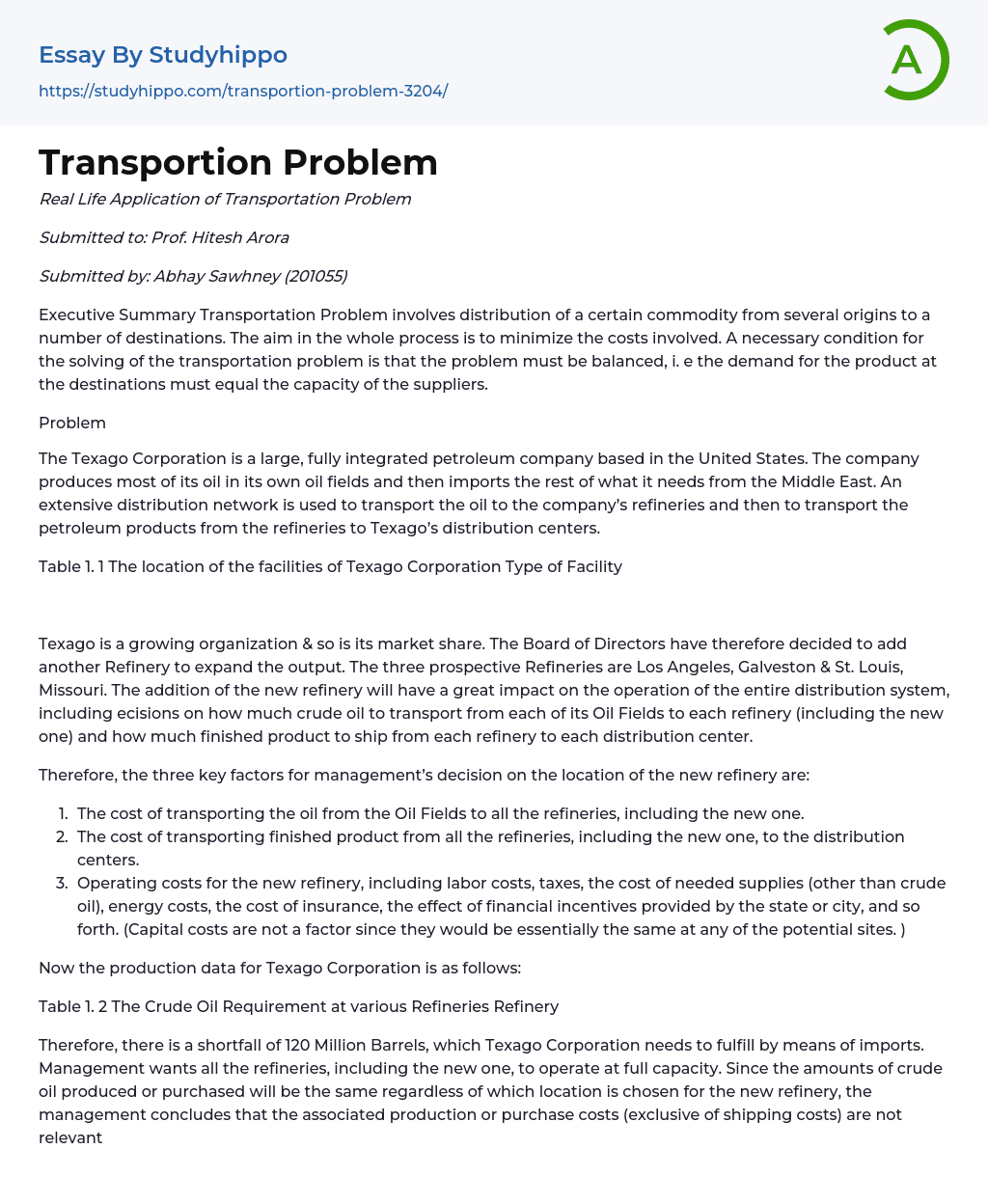Real Life Application of Transportation Problem
Submitted to: Prof. Hitesh Arora
Submitted by: Abhay Sawhney (201055)
Executive Summary Transportation Problem involves distribution of a certain commodity from several origins to a number of destinations. The aim in the whole process is to minimize the costs involved. A necessary condition for the solving of the transportation problem is that the problem must be balanced, i. e the demand for the product at the destinations must equal the capacity of the suppliers.
Problem
The Texago Corporation is a large, fully integrated petroleum company based in the United States. The company produces most of its oil in its own oil fields and then imports the rest of what it needs from the Middle East. An extensive distribution network is used to transport the oil to the company’s refineries and then to transpo
...rt the petroleum products from the refineries to Texago’s distribution centers.
Table 1. 1 The location of the facilities of Texago Corporation Type of Facility
Texago is a growing organization & so is its market share. The Board of Directors have therefore decided to add another Refinery to expand the output. The three prospective Refineries are Los Angeles, Galveston & St. Louis, Missouri. The addition of the new refinery will have a great impact on the operation of the entire distribution system, including ecisions on how much crude oil to transport from each of its Oil Fields to each refinery (including the new one) and how much finished product to ship from each refinery to each distribution center.
Therefore, the three key factors for management’s decision on the location of the new refinery are:
- The cost of transporting the oil from the
Oil Fields to all the refineries, including the new one.
Now the production data for Texago Corporation is as follows:
Table 1. 2 The Crude Oil Requirement at various Refineries Refinery
Therefore, there is a shortfall of 120 Million Barrels, which Texago Corporation needs to fulfill by means of imports. Management wants all the refineries, including the new one, to operate at full capacity. Since the amounts of crude oil produced or purchased will be the same regardless of which location is chosen for the new refinery, the management concludes that the associated production or purchase costs (exclusive of shipping costs) are not relevant to the site selection decision.
The costs for transporting the crude oil from its source to a re-finery are very relevant, which are as follows:
Table 1. 4 Cost of transporting Cruse Oil from an Oil Field to the refinery
Table 1. 5 Cost of shipping the Finished product from the Refineries to the Distribution Centres
CHECKING THE OPERATING COSTS FOR LOS ANGELES
Using Solver & Excel, when we solve the Transportation problem for the supply from Oil Wells to the refineries, we get the following Optimal Solution. The Minimum cost is $ 880 Million. Now, we look at the minimum operating
costs incurred when we ship the petroleum from the Oil Refineries to the Distribution Centres. Following is the solution: The Cost incurred after shipping the petroleum to the Distribution Centres is $1570 Million.
So, the minimum cost that Texago Corporation will have to incur when they set up their refinery at Los Angeles will be 880+1570 i. e. $2450 Million.
OPERATING COSTS FOR GALVESTON
Now, for Galveston the Shipping Costs for transporting Oil from Wells to the Refinery will be $920 Million, as solved in Excel. Now the Minimum Shipping Costs that will be incurred when transporting Petroleum from Galveston to the Distribution Centres turns out to be $1630 Million. The Total Cost that has to be incurred will be $2550 Million.
CALCULATING THE SHIPPING COSTS FOR St. LOUIS
Again, the Shipping Costs will have to be calculated for transporting Oil from various Oil Wells to the refineries. The Minimum Cost this time is $920 Million. And the Shipping Costs for transporting Petroleum from the Refineries to the Distribution Centres turn out to be $1430 Million The total cost here is $2350 Million. We see that the Shipping Costs will be minimized if the New Refinery is established at St. Louis.
CONCLUSION
Therefore, we see that the Transportation Problem plays a pivotal role in any organization as it helps the management and employees decide which strategy to take up, so as to minimize the costs.
Also, it can help them maximize the returns from a particular venture. However, Transportation Problem has its own limitations as it does not include any other factors such as operating costs, capital expenditures, revenue expenditures etc. Though these can be incorporated in the analysis, separately.
REFERENCES
Operations Research, By C.
K. Mustafi, New Age International Pvt. Ltd. , Publishers. Quantitative Techniques in Management, By N. D. Vihra, Tata McGraw Hill
- Chief Executive Officer essays
- Convenience Store essays
- Firm essays
- Training And Development essays
- Unilever essays
- Variable Cost essays
- Virgin Group essays
- Bargaining essays
- Entity essays
- Pest analysis essays
- Finance essays
- International Business essays
- Macroeconomics essays
- Barriers To Entry essays
- Microeconomics essays
- Pricing essays
- Profit essays
- Consumerism essays
- Export essays
- Free Trade essays
- International Trade essays
- Compensation essays
- Monopoly essays
- Trade essays
- Industry essays
- Warehouse essays
- Economic Development essays
- Economic Growth essays
- Inflation essays
- Taxation essays
- Central Bank essays
- Monetary Policy essays
- Economy essays
- Gross Domestic Product essays
- Recession essays
- Capitalism essays
- Economic System essays
- Materialism essays
- World economy essays
- American Dream essays
- resources essays
- Max Weber essays
- Employment essays
- Minimum Wage essays
- Unemployment essays
- Human Development essays
- Income Inequality essays
- Economic Inequality essays
- Money essays
- Financial Accounting essays




